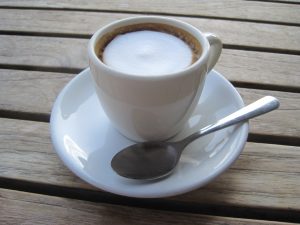47 Learning Materials and Exercises
What is the Best Way to Cool Coffee?

What is the best way to cool coffee? What option would you choose?
Why?
Option 1
Wait 5 minutes and add milk.
Option 2
Add milk and wait 5 minutes.
Assume that the temperature and volume of milk, temperature and volume of coffee, and the composition and the size of a cup are the same.
Image credit: Walsh, J. (2010). Wikimedia Commons. https://commons.wikimedia.org/wiki/File:Cup_of_coffee_5084862159.jpg
Textbook Material
Read:
Chapter 14
Heat and Heat Transfer Methods
14.2 Temperature Change and Heat Capacity
14.3 Phase Change and Latent Heat
Solving the Effect of Heat Transfer Problems: A strategy
- Examine the situation to determine that there is a change in the temperature or phase. Is there heat transfer into or out of the system?
When the presence or absence of a phase change is not obvious, you may wish to first solve the problem as if there were no phase changes and examine the temperature change obtained. If it is sufficient to take you past a boiling or melting point, you should then go back and do the problem in steps—temperature change, phase change, subsequent temperature change, and so on.
2. Identify and list all objects that change temperature and phase.
3. Identify exactly what needs to be determined in the problem (identify the unknowns).
A written list is useful.
4 . Make a list of what is given or what can be inferred from the problem as stated (identify the knowns).
5. Solve the appropriate equation for the quantity to be determined (the unknown).
If there is a temperature change, the transferred heat depends on the specific heat (see Table 14.1) whereas, for a phase change, the transferred heat depends on the latent heat (see Table 14.2).
6. Substitute the knowns along with their units into the appropriate equation and obtain numerical solutions complete with units.
You will need to do this in steps if there is more than one stage to the process (such as a temperature change followed by a phase change).
7. Check the answer to see if it is reasonable: Does it make sense?
As an example, be certain that the temperature change does not also cause a phase change that you have not taken into account.
Textbook Exercises
Solve the following problems:
Chapter 14
- Conceptual Questions: 1 – 4, 6 – 9, 17, 18, 21, 23, 26, 27.
- Problems & Exercises: 1 – 5, 9, 11, 15, 24 – 26, 32 – 34, 45, 46, 55.
Solving Problems in Physics

Note: Image by Chudaeva, E. (2022).
Formulas
Modify this list as you wish to support your learning.
Elena’s explanation of how to approach and solve problems on heat and heat transfer
Check this handout with problems and steps involved in solving these problems and thinking processes that Elena used to solve these problems.
Modify this handout as you wish to support your learning.
Additional Resource
OpenStax High School Physics, chapter 11 Thermal energy, Heat, and Work

